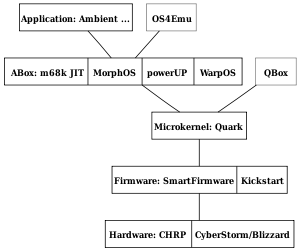MorphOS
 | |
| Developer | The MorphOS Development Team |
|---|---|
| Written in | C |
| OS family | AmigaOS-like |
| Working state | Current |
| Source model | Closed source (with open source components) |
| Initial release | 0.1 / August 1, 2000 |
| Latest release | 3.9 / June 19, 2015 |
| Available in | 19 languages |
| Platforms | Pegasos, some models of Amiga, EFIKA, Mac Mini G4, eMac, Power Mac G4, PowerBook G4, iBook G4, Power Mac G5, SAM 460 |
| Kernel type | Micro/pico[1] |
| Default user interface | Ambient |
| License | Proprietary with GNU GPL Ambient user interface |
| Official website |
www |
MorphOS is an AmigaOS-like computer operating system. It is a mixed proprietary and open source OS produced for the Pegasos PowerPC processor based computer, PowerUP accelerator equipped Amiga computers, and a series of Freescale development boards that use the Genesi firmware, including the EFIKA and mobileGT. Since MorphOS 2.4, Apple's Mac Mini G4 is supported as well, and with the release of MorphOS 2.5 and MorphOS 2.6 the eMac and PowerMac G4 models are respectively supported. The release of MorphOS 3.2 added limited support for PowerMac G5. The core, based on the Quark microkernel, is proprietary, although several libraries and other parts are open source, such as Ambient desktop.
Characteristics and versions
Developed for PowerPC processors from Freescale and IBM while supporting the original AmigaOS MC680x0 applications via proprietary task-based emulation, and most AmigaOS/PPC applications via API wrappers. It is API compatible with AmigaOS 3.1 and has a GUI based on MUI.
Besides the Pegasos version of MorphOS, there is a version for Amiga computers equipped with PowerUP accelerator cards produced by Phase5. This version is free, although it does slow down after each two-hour session if it has not been registered. Registration is free. PowerUP MorphOS was most recently updated on 23 February 2006; however, it does not exceed the feature set or advancement of the Pegasos release.[2][3]
A version of MorphOS for the EFIKA, a very small mainboard based on the ultra-low wattage MPC5200B processor from Freescale, has been shown at exhibitions and user-gatherings in Germany.[4] Current (since 2.0) release of MorphOS supports the EFIKA.
Components


ABox
ABox is an emulation sandbox featuring a PPC native AmigaOS API clone that is binary compatible with both 68k Amiga applications and both PowerUP and WarpOS formats of Amiga PPC executables. ABox is based in part on AROS Research Operating System. ABox includes Trance JIT code translator for 68k native Amiga applications.
Other
- AHI – audio interface: 6.7
- Ambient desktop – the default MorphOS desktop, inspired by Workbench and Directory Opus 1.43
- CyberGraphX – graphics interface originally developed for Amiga computers: 5.1
- Magic User Interface – primary GUI toolkit: 4.2
- Poseidon – the Amiga USB stack developed by Chris Hodges
- TurboPrint – the printing system
- TinyGL – OpenGL implementation and Warp3D compatibility is featured via RAVE low-level API: V 51
- Quark – manages the low level systems

MorphOS software
MorphOS can run any system friendly Amiga software written for 68k processors. It also provides compatibility layer for PowerUP and WarpUP software written for PowerUP accelerator cards. The largest repository is Aminet with over 75000 packages online with packages from all Amiga flavors including music, sound and artwork. MorphOS only software repositories are hosted at MorphOS software and MorphOS files.
Bundled applications
MorphOS is delivered with a number of desktop applications in the form of pre-installed software.
Supported hardware
- max. 1.5 GB RAM, no virtual memory possible.
- Nvidia cards are not supported.
Amiga
- Amiga 1200 with Blizzard PPC accelerator card
- Amiga 3000 with CyberStorm PPC accelerator card
- Amiga 4000 with CyberStorm PPC accelerator card
Apple
Genesi/bPlan GmbH
ACube
History

The project started in 1999, based on the Quark microkernel. The earliest versions of MorphOS ran only via PPC accelerator cards on the Amiga computers, and required portions of AmigaOS to fully function. A collaborative effort between the companies bPlan (of which the lead MorphOS developer is a partner) and Thendic-France in 2002 resulted in the first regular, non-prototype production of bPlan-engineered Pegasos computers capable of running MorphOS or Linux. A busy promotional year followed in 2003, with appearances at conventions and exhibitions in several places around the world, including CES in Las Vegas. Thendic-France had financial problems and folded; however, the collaboration continued under the new banner of "Genesi".
After some bitter disagreements within the MorphOS development team in 2003 and 2004, culminating with accusations by a MorphOS developer that he and others had not been paid, the Ambient desktop interface was released under GPL and is now actively developed by the Ambient development team. Subject to GPL rules, Ambient continues to be included in the commercial MorphOS product. An alternative MorphOS desktop system is Scalos.[6]
On April 1, 2008, the MorphOS team announced that MorphOS 2.0 would be released within Q2/2008. This promise was only kept by a few seconds, with the release of MorphOS 2.0 occurring on June 30, 2008 23:59 CET. MorphOS 2 is commercially available at a price of 150 EUR per machine (111.11 EUR as a special promotion within the first two weeks of its release). A fully functional demo of MorphOS is available, but without a keyfile, its speed is decreased significantly after 30 minutes of use.
Release history of 0.x/1.x series
| Version | Release date | Notes |
|---|---|---|
| 0.1 | August 1, 2000 | Amiga |
| 0.2 | October 17, 2000 | Amiga |
| 0.4 | February 14, 2001 | 3rd Release[7] |
| 0.5 | May 1, 2001 | Amiga |
| 0.8 | August 2001 | Amiga, Pegasos I |
| 0.9 | 2002 | beta[8] |
| 1.0 | 14 October, 2002 | Pegasos I |
| 1.1 | December 13, 2002 | Pegasos I |
| 1.2 | February 9, 2003 | Pegasos I |
| 1.3 | March 27, 2003 | Pegasos I |
| 1.4 | August 7, 2003 | Pegasos I |
| 1.4.4 | March 28, 2005 | Pegasos I/II |
| 1.4.5 | April 30, 2005 | Pegasos I/II |
| 1.4.5 | August 25, 2005 | Amiga[9] |
Release history of 2.x/3.x series
| Version | Release date | Notes |
|---|---|---|
| 2.0 | June 30, 2008 | Added support for Efika 5200B platform; native TCP/IP stack, an updated Sputnik release, AltiVec support, alpha compositing 3D layers for the graphical user interface, new USB components (including USB 2.0 support), new screenblankers, and Reggae, a new, modular, streaming multimedia framework[10] |
| 2.1 | September 6, 2008 | Support for the EFIKA's audio[11] |
| 2.2 | December 20, 2008 | TrueCrypt-compatible disk encryption suite[12] |
| 2.3 | August 6, 2009 | Origyn Web Browser as the default browser, read only HFS+ filesystem support[13] |
| 2.4 | October 12, 2009 | Added support for Mac mini G4; Write support for Mac HFS disks, new charsets.library to provide better multilingual application support[14] |
| 2.5 | June 4, 2010 | Added support for eMac G4; drivers for SiI3x1x based 2-port Serial ATA PCI cards[15] |
| 2.6 | October 10, 2010 | Added support for Power Mac G4; 2D drivers for Rage 128 Pro graphics cards; Released at precisely 10.10.10 10:10[16] |
| 2.7 | December 2, 2010 | Improving support for Power Mac G4 platforms[17] |
| 3.0 | June 8, 2012 | Added support for PowerBook G4; performance improvements[18] |
| 3.1 | July 8, 2012 | Bug-fix release[19] |
| 3.2 | May 27, 2013 | Added support for further PowerBook G4 models, iBook G4 and Power Mac G5 model A1047; 3D drivers for Radeon R300 based cards, wireless networking via Atheros chipset, major overhaul of TCP/IP stack ("NetStack") - improving networking performance[20] |
| 3.3 | September 18, 2013 | Fixes support for some iBook G4 models[21] |
| 3.4 | December 14, 2013 | Improved R300 3D and G5 video playback performance, support for non-native display resolutions on various PowerBook models[22] |
| 3.5 | February 15, 2014 | Support for PowerMac7,2 Power Mac G5 models[23] |
| 3.6 | June 27, 2014 | Broadcom Wi-Fi support, AMD R400 support, SMBFS filesystem, VNC server and a Synergy client[24] |
| 3.7 | August 3, 2014 | Bug-fix release[25] |
| 3.8 | May 15, 2015 | Support for Sam 460 series of mainboards; basic drivers for Radeon HD series graphics cards, support for 4K displays in their native resolution[26] |
| 3.9 | June 19, 2015 | Bug-fix release[27] |
MorphOS 2 includes a native TCP/IP stack ("Netstack") and a web browser, Sputnik or Origyn Web Browser.[28] Sputnik was begun under a user community bounty system[29] that also resulted in MOSNet, a free, separate TCP/IP stack for MorphOS 1 users. Sputnik is a port of the KHTML rendering engine, which WebKit is also based on. Sputnik is no longer developed and was removed from later MorphOS 2 releases.

See also
References
- ↑ "Basic Kernel Information". MorphOS Home Page. Retrieved 2007-03-21.
- ↑ Piru (February 23, 2006). "Announcements : Updated MorphOS for PowerUP Users". Amiga.org. Archived from the original on 2007-03-14. Retrieved 2007-03-21.
- ↑ Thom Holwerda (August 24, 2005). "MorphOS 1.4.5 Released for Classic Amiga". OSNews. Retrieved 2007-03-21.
- ↑ Thom Holwerda (October 17, 2006). "MorphOS 1.5 Running on EFIKA to Be Shown". OSNews. Retrieved 2007-03-21.
- ↑ Frank Mariak (December 25, 2013). "MorphOS on Apple G4 Cube?". Retrieved 2013-12-25.
- ↑ Chris Haynes (March 21, 2007). "Scalos - The Amiga Desktop Replacement". Retrieved 2007-03-21.
- ↑ "New MorphOS 0.4 Release". ann.lu. February 15, 2001. Archived from the original on February 15, 2001. Retrieved 2016-11-22.
- ↑ MorphOS 0.9 video
- ↑ "MorphOS Change Log". morphos-team.net. June 6, 2006. Retrieved 2016-11-22.
- ↑ MorphOS 2.0 release notes
- ↑ MorphOS 2.1 release notes
- ↑ MorphOS 2.2 release notes
- ↑ MorphOS 2.3 release notes
- ↑ MorphOS 2.4 release notes
- ↑ MorphOS 2.5 release notes
- ↑ MorphOS 2.6 release notes
- ↑ MorphOS 2.7 release notes
- ↑ MorphOS 3.0 release notes
- ↑ MorphOS 3.1 release notes
- ↑ MorphOS 3.2 release notes
- ↑ MorphOS 3.3 release notes
- ↑ MorphOS 3.4 release notes
- ↑ MorphOS 3.5 release notes
- ↑ MorphOS 3.6 release notes
- ↑ MorphOS 3.7 release notes
- ↑ MorphOS 3.8 release notes
- ↑ MorphOS 3.9 release notes
- ↑ "MorphOS 2.0". Retrieved 2010-06-19.
- ↑ "Morph Bounties". MorphZone. Archived from the original on 2007-03-06. Retrieved 2007-03-12.
External links
- Aminet Amiga/MorphOS software repository
- Official website
- MorphZone, Supported Computers
- MorphOS Software Database
- MorphOS software repository
- MorphOS: The Lightning OS
- Obligement – Magazine about AmigaOS and MorphOS
- warmup-asso.org – Portal dedicated to MorphOS users.